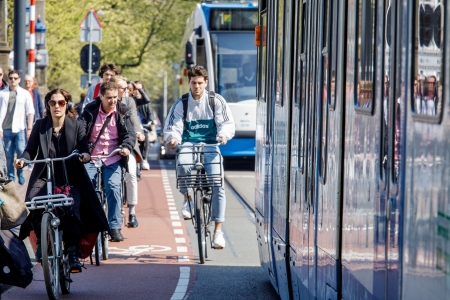From 2012 to 2016, Prorail registered an annual average of 32 railway crashes; they accounted for an annual average of 13 fatalities or serious injuries [18]. The Netherlands thus take fifth place in a list of 28 safest railway countries (of all EU countries, plus Switzerland and Norway), after corrections for the number of train kilometres and population density [18].
Table 2 shows the number of railway crashes for passenger lines, which are responsible for almost all fatalities and serious injuries (97% in 2012-2016), identified by the extent to which the crossing is protected.
|
Crossing category |
Number of railway crossings |
Annual number of crashes |
Annual fatalities |
|||
|
Protected by lights and barriers |
1507 |
63% |
20.8 |
65% |
10.6 |
79% |
|
Protected by lights only |
19 |
1% |
0.2 |
1% |
0 |
0% |
|
Unprotected –public level crossing |
117 |
5% |
3.2 |
10% |
2.2 |
16% |
|
Unprotected private level crossing |
214 |
9% |
0.6 |
2% |
0.2 |
2% |
|
Total number of passenger lines |
1857 |
78% |
24.8 |
78% |
13.0 |
97% |
Table 2. Number of level crossings, crashes and fatalities for passenger lines[i].
In 2012-2016, most road casualties occurred at Active Level Crossings (ALCs; see Figure 3). But, relatively speaking, more casualties occurred at Passive Level Crossings (PLCs; Figure 3) in that same period. Passive level crossings accounted for approximately 16% of all railway deaths and serious injuries, while PLCs made up only 5% of the main railway network (see Table 2). When the railway intersects with a private road, electric fences and St Andrew’s crosses[ii]; are often missing; however, on these roads crossing traffic is extremely limited.
 Figure 3. Left: illustration of a Passive Level Crossing (PLC), usually only protected by St Andrew’s crosses[ii] and warning signs. Right: illustration of an Active Level Crossing (ALC) protected by (half) barriers, St Andrew’s crosses, warning signs, sound and light alarms.
Figure 3. Left: illustration of a Passive Level Crossing (PLC), usually only protected by St Andrew’s crosses[ii] and warning signs. Right: illustration of an Active Level Crossing (ALC) protected by (half) barriers, St Andrew’s crosses, warning signs, sound and light alarms.
In defiance of barriers and warnings, travellers still cross the railway quite frequently. Also see the question What measures are taken to improve road safety around railway tracks?
[i]. Table 2 originates from research by the Dutch Safety Board [18]. The number of level crossings is the mid-2017 number, the annual number of crashes/casualties are averages for 2012-2016. The percentages (per column) are expressed as values for the entire main railway network (passenger lines and freight lines combined: 2.375 level crossings, annual number of casualties for the entire railway network 13,4).
[ii]. A St Andrew’s Cross is a red/white cross indicating the number of tracks at a level crossing, each cross indicates one track.
